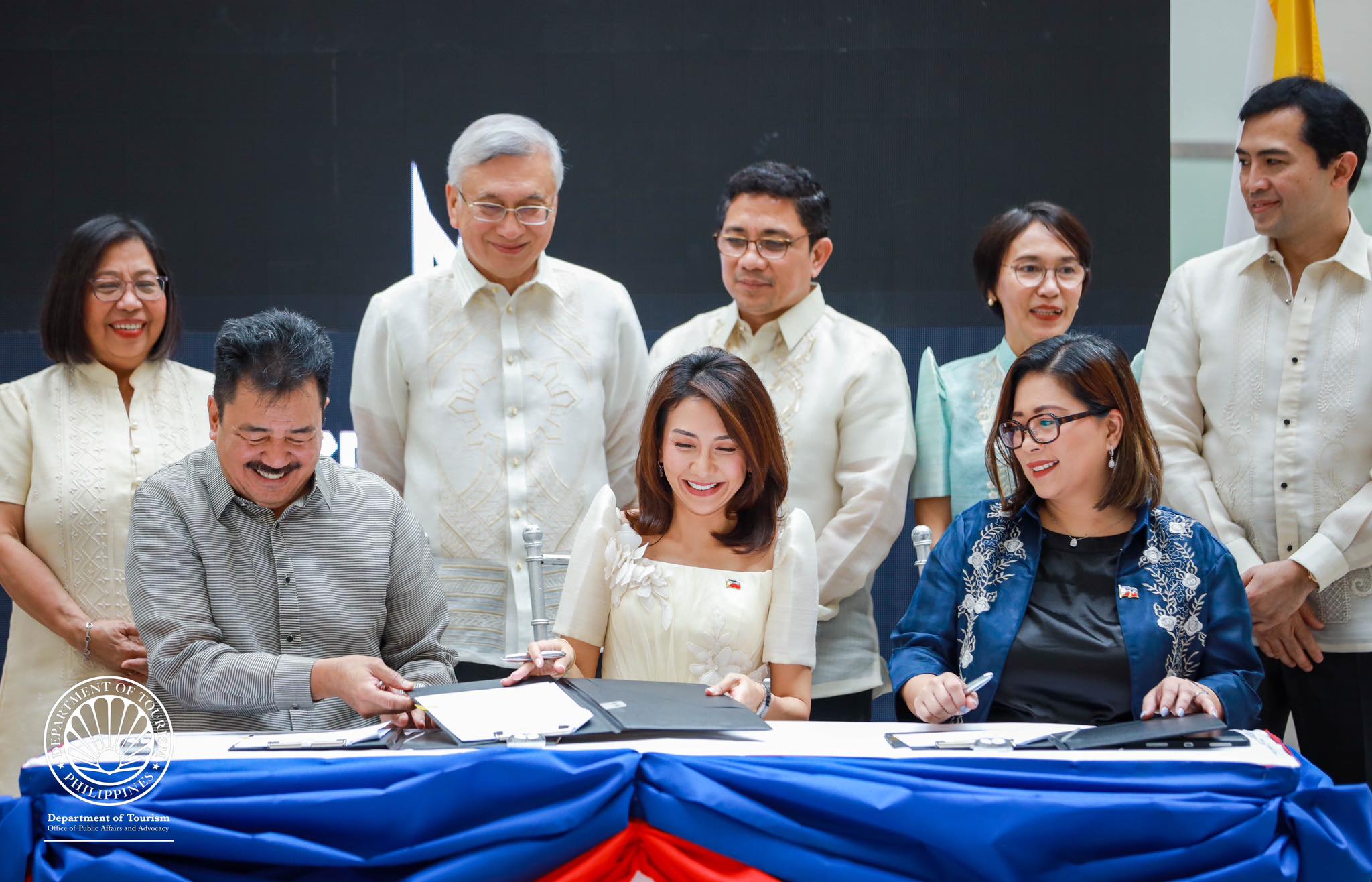

MANILA, Philippines – The Department of Tourism (DOT) expressed optimism that the signing of the guidelines on the utilization of the Higer Education Development Fund (HEDF) will boost tourism-related courses and programs in the country.
Tourism Secretary Christina Garcia Frasco, who led the ceremonial signing of a Joint Administrative Order (JAO) on Monday, March 24, with Assistant Chief Operating Officer Karen Mae Sarinas-Baydo representing TIEZA Chief Operating Officer Mark Lapid, and CHED Chairperson J. Prospero De Vera III, remarked that under the Marcos Administration, the mandate of the DOT is “not just to promote but to develop tourism.”
Under Section 10 of Republic Act 7722 or the Higher Education Act of 1994, the law states that the continuing government’s contribution to the HEDF shall be taken from the 40% annual share on the total gross collections of the travel tax; 30% annual share of the collections from the Professional Registration Fee; and 1% of the gross sale of the lotto operation of the Philippine Charity Sweepstakes Office.
Further, Section 73 of the Republic Act 9593 or the Tourism Act of 2009, states that the contribution to the HEDF equivalent to forty percent (40%) from the total gross collections of the travel tax shall be retained, provided that tourism-related educational programs and courses is given priority by the CHED.
According to the DOT, the newly signed JAO outlines how these funds will be utilized to advance tourism education and development.
Priority areas for funding include: the construction, or improvement of facilities and/or demo labs for tourism and hospitality-related courses including the purchase of industry-grade equipment to support the facility; funding for industry immersion program and career development for teachers and students; support for technology innovations or digitalization in tourism and hospitality programs; support for start-up/incubation centers on tourism and hospitality; research and development for enhancement of tourism-related programs and courses; and support to tourism education-related programs and education tourism programs to be implemented in partnership with the DOT and Higher Education Institutions (HEIs), the DOT explains.
“At the onset of the Marcos Administration, when I was newly appointed Secretary as early as August of 2022, I wrote a formal communication to chair De Vera of CHED to request a utilization report of the funding that they had received from TIEZA and to determine whether the funds were used for tourism education. This conversation has stood for a couple of years, and it has since seen fruition with the signing of the Joint Administrative Order today,” Frasco reflected.
“It is our sincere hope that by way of instituting clear, fair, as well as stakeholder-driven programs under the JAO, the funds that our fellow Filipinos pay in travel taxes are devoted in full to education programs that will further expand opportunities for young people to join the tourism industry and expand economic opportunities from our local destinations, who will inevitably benefit from a tourism workforce that is well educated, well capacitated and world-class in terms of skills,” she added.
As a former educator herself, who once taught international law before being hand-picked as secretary of tourism, the tourism chief said she felt a “deep sense of joy and gratitude” in the signing of the JAO.
“The investment that our national government is making in our students underscores the seriousness of the Marcos administration's commitment to tourism education. This extends beyond new scholarships, for it encompasses groundbreaking research, targeted faculty development, and collaborative educational programs that directly align with the evolving demands of the global tourism landscape,” Frasco stated.
“With meaningful engagement with our stakeholders, particularly in the private sector, it is critical to bridge gaps. And so, we fully intend to have a continuous conversation with the private sector to ensure that tourism education is always up to date with local trends, and can increase the effectiveness of our tourism workers,” she noted.

(Photo courtesy of Department of Tourism)
Meanwhile, CHED Chairperson De Vera acknowledged DOT’s efforts in pushing for a JAO on the guidelines of the utilization of the HEDF.
“Now that we have clear guidelines and basis to provide support for higher education institutions, for the establishment of their facilities, the modernization of the equipment, the improvement of their curriculum, the development of their resources, we can now say that we can continue to produce graduates that match the standards and demands of the tourism and hospitality industry here and all over the world,” De Vera mentioned.
“We will also be able to provide more grants for research and development for the enhancement of tourism-related programs and courses. We can send more faculty members to top tourism universities and institutions abroad for upskilling and reskilling programs as instructed by the President so that our faculty members are addressed and upskilled as far as tourism promotion is concerned,” he added.
De Vera added that with the signing of the JAO, more tourism and hospitality development programs will be prioritized in the future.
For TIEZA Assistant Chief Operating Officer (COO) Karen Mae Sarinas-Baydo, she shared that over the past 10 years, the DOT’s infrastructure arm has remitted PHP17.3 billion to CHED.
“Our combined efforts will ensure that every peso from the Travel Tax goes to funding innovative programs while creating industry-immersion opportunities and capacity-building initiatives to develop future tourism professionals and leaders,” Sarinas-Baydo stated.
“So, by prioritizing tourism education, we are investing in our nation's most valuable asset, its people, and setting a solid foundation for the sustainable growth and the future of Philippine tourism,” she said.




